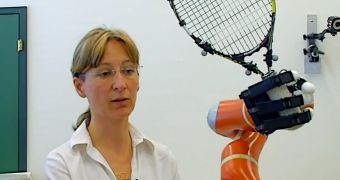Just yesterday we wrote about a prosthetic arm that could mimic all human arm movements, and which was being heralded as a “Star Wars” arm, even though it was still pretty slow. Now, though, we've come across an arm that moves much faster.
In fact, the arm not only moves very quickly, but also shows a degree of coordination rarely encountered in robots, and it works independent from human input too.
A team of Engineers from Switzerland invented it. It's an arm that can catch objects thrown at it, although only after it fails to do so a bunch of times.
The core of the success is “programming by demonstration.” The robot is run by a software that can learn from past experiences.
In the video below you can see one of the inventors moving the arm to test its mobility, and to “inform” the arm itself of that mobility.
Then, the engineers grab the arm and guide it in the path of whatever objects the other is throwing, all the while not “telling” the arm anything, not even what it's supposed to do.
The robotic arm deduces by itself what task it should carry out, and eventually learns how to snatch airborne objects on its own.
Obviously, it needs to move pretty quickly in order to do that, much more quickly than the prosthetic arm we have mentioned before.
It's a promising concept, especially if it gets adapted for replacement limbs. We imagine it would only take some sessions in the hospital to “teach” the leg or arm what to do and how.
It would definitely be a step up from a comparatively slow mechanic limb, which also happens to need you to sometimes hop or hobble on your feet in order to change its position or grips.
The joint motors on the new robotic arm from Switzerland appear to be significantly more mobile as well.
The only thing left is to make the thing smaller. After all, at a height of 1.5 meters / 5 feet, it's not exactly conductive to prosthetic applications. It shouldn't be an insurmountable task, however. Not when we have such good incentive (the ability to make adjustments in as little as 1/500 second).
A robotic limb based on it would probably lack the 360-degree mobility, for the sake of familiarity if nothing else, but everything else would work perfectly.
Or the engineers' breakthrough will be employed in military drones and bots, you never know. Most likely, both possibilities will come to pass, provided that costs don't prove too massive.

 14 DAY TRIAL //
14 DAY TRIAL // 